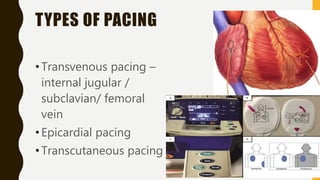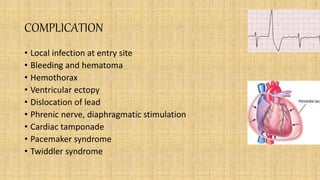Pacemaker
- 2. PACEMAKER PRINCY FRANCIS M II Yr MSc (N) JMCON
- 3. • 1932 - Albert Hyman coined term “Artificial pacemaker” • 1958 – first implantable pacemaker designed by Rune Elmquist
- 4. Definition A pacemaker is an electronic device that provides electrical stimuli to the heart muscle.
- 5. INDICATION - ACC, AHA and Heart Rhythm Society Class I (procedure to be performed) • Sinus node dysfunction • Acquired atrioventricular block • Chronic bifascicular block • After acute MI
- 6. INDICATION cont… •Hypersensitive carotid sinus syndrome and neurocardiogenic syncope •After cardiac transplantation •Pacing to prevent tachycardia •Patients with congenital heart disease
- 7. Class II procedures can be performed but additional studies are needed • Sustained VT • Unexplained Syncope • Nonischemic cardiomyopathy • Permanent pacemaker that automatically detect and pace to terminate tachycardia • Cardiac sarcoidosis, Chagas disease • Brugada syndrome Class III procedures should not be performed
- 9. PERMANENT PACEMAKER • The permanent pacemaker source is implanted subcutaneously usually over the pectoral muscle on the patient’s nondominant side • It is attached to pacing leads, which are threaded intravenously to the right atrium and one or both ventricles.
- 10. TEMPORARY PACEMAKER • Temporary pacemaker are used to support the patient until patient condition improve or receive a permanent pacemaker.
- 11. TYPES OF PACING •Transvenous pacing – internal jugular / subclavian/ femoral vein •Epicardial pacing •Transcutaneous pacing
- 12. TYPES BASED ON CHAMBER BEING PACED • Single chamber pacing: one lead • Dual chamber pacing : 2 lead • Biventricular pacing / Cardiac resynchronization therapy : 3 leads connecting to right atrium and both ventricles
- 13. Components Electronic pulse generator – circuit and battery Rate (beats/mt) Output (mA) Sensitivity (mV) Pacemaker electrodes - leads
- 14. PACEMAKER CODE • Universal code – NASPE and BPEG First letter Chamber paced Second letter Chamber sensed Third letter Response after Sensing Fourth letter Rate modulation Fifth letter Multisite pacing A – Atrium A – Atrium I - Inhibited O - No rate responsiveness A – Atrium V - Ventricle V - Ventricle T - Triggered R – Rate modulation V - Ventricle D - Dual D - Dual D - Dual D - Dual O – None O - None O – None
- 15. Pacemaker spikes
- 16. MAGNET INHIBITION Used to inhibit the device Reprograms the pacer into an asynchronous pacing mode; it does not turn the pacemaker off. Determine the pacer’s battery to be replaced.
- 17. COMPLICATION • Local infection at entry site • Bleeding and hematoma • Hemothorax • Ventricular ectopy • Dislocation of lead • Phrenic nerve, diaphragmatic stimulation • Cardiac tamponade • Pacemaker syndrome • Twiddler syndrome
- 18. PACEMAKER MALFUNCTION • Loss of capture : complex doesnot follow pacing site • Under sensing : pacing spike occurs at preset intervals despite of patient’s rhythm. • Oversensing : pacing doesn’t occur at preset interval • Lack of pacing : total absence of pacing spikes • Rhythmic diaphragmatic or chest wall twitching
- 19. NURSING MANAGEMENT • Preoperative care Assess knowledge and understanding level Collect blood reports, Chest Xray, ECG, Echo, Holter report Get informed consent signed Place ECG monitor electrodes away from potential incision sites
- 20. Post operative care • Provide postoperative monitoring, analgesia and care • Obtain postop chest Xray to identify lead location and detect possible complication • Provide comfortable position. Restricting movement of extremities • Assist with gentle ROM exercise atleast 3 times daily, beginning 24 hrs after pacemaker implantation • Monitor pacemaker function with cardiac monitoring and report pacemaker problems to physician. • Assess for dysrrhythmia and treat as indicated • Provide pacemaker identification card.
- 21. Patient teaching Placement of the pacemaker generator and leads How the pacemaker works and rate at which it is set. Battery replacement How to take and record pulse rate. Incision care and signs of infection Signs of pacemaker malfunction to report including dizziness, fainting, fatigue, weakness, chestpain or palpitation.
- 22. Activity restrictions. Limit to contact sports and avoid heavy lifting for 2 months after surgery Avoid tight fitting clothings Notify all care providers of the pacemaker Carry pacemaker ID card Do not hold or use certain electrical devices over pacemaker site including household appliances , antitheft devices. Maintain follow up care with physician
- 23. BIBLIOGRAPHY • Woods LS, Froelicher SSE, Motzer US, Bridges EJ. Cardiac Nursing. 6th edition. Baltimore: Wolters Kluwer Publication; 2010 • Smeltzer S C, Bare B , Brunner &suddarth’s Medical surgical nursing, edition 10th, ( 2000), Westline Industrial drive, Missouri. • Pacemaker - American Heart Association www.heart.org/HEARTORG/Conditions/.../Pacemaker_U CM_448480_Article.jsp























